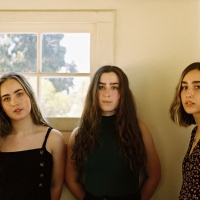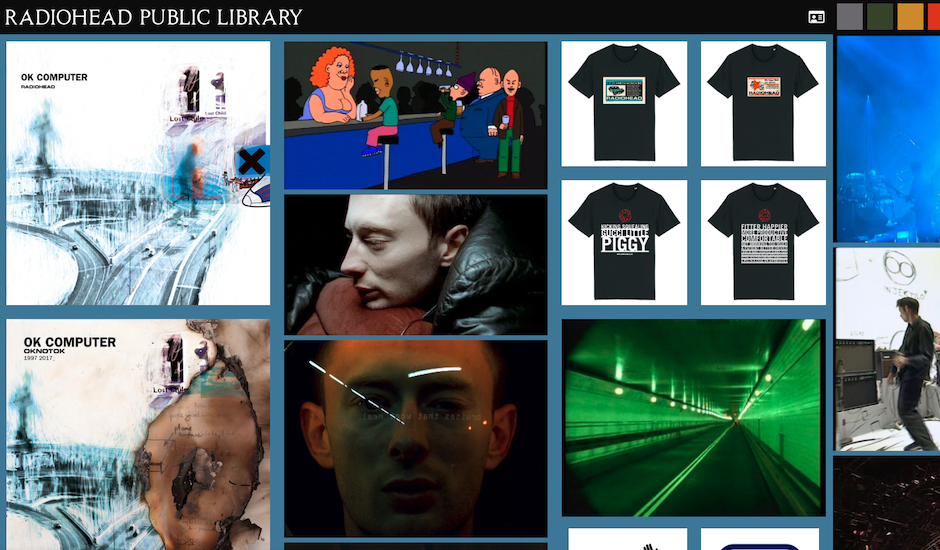 Introducing Little Quirks, the family folk band putting out a new EP, Cover My EyesAlongside the release of their latest EP today, the trio have also announced a stack of tour dates to take them across the country.
Introducing Little Quirks, the family folk band putting out a new EP, Cover My EyesAlongside the release of their latest EP today, the trio have also announced a stack of tour dates to take them across the country.

Life In A Glasshouse: Your guide to the huge Radiohead Public Library
Whilst the Radiohead Public Library might feel nostalgic, it’s an inspired initiative that strengthens their legacy as much as it champions archival preservation.
Much has been written of Radiohead.
In fact, there’s so much literature on the reclusive-yet-omnipresent outfit that they can sometimes feel more like a cultural presence than an actual band. Their songs have been pored over; their records acclaimed; their members interrogated and their stylistic shifts hailed, and yet, as the members find their own lanes and their creative process becomes longer and longer still, the band has always been a little reticent to engage with the past. They’d probably prefer you forget about Pablo Honey, anyway.
It’s entirely unsurprising that I should love Radiohead, given my age and my demographic. Born in the moments before OK Computer and raised in the future it so furiously foretold, I came to know the group through Baz Luhrmann and Coldplay, the latter some strange inversion of the natural order. It’s fair to say that, though I cottoned on sometime in high school, there was a whole lot that I missed. The band’s new initiative, the Radiohead Public Library, does something to plug those gaps.
Preservation isn’t as much a dirty word as it is a remarkably boring one. It rears its head infrequently, and usually only in response to some historical disaster, such as the recently-uncovered 2008 fire that ravaged the Universal Studios lot and destroyed the master recordings of some 400 artists. That fire represented not only the loss of master-quality tapes, but it tore through entire eras and schools of creatives, staining the legacy of blues innovators, ‘90s singer-songwriters and hip-hop crossover acts all the same. If the master recordings represented the most immediate loss, it’s the interstitial sounds – offcuts, b-sides, the spontaneous sounds of in-studio creativity – that quietly went up in smoke.
It only made matters worse that Universal concealed the damage for more than a decade, even going as far as to obfuscate and evade when asked for reissue materials by Bryan Adams. It’s been almost a year since The New York Times broke the news of that injustice, and though their damage control involved little more than remastering a small host of vintage music videos, Universal seem to have been all but freed by the court of public opinion. If any sentence was handed down, it was a brief one, and the reputational time served couldn’t even rival one-hundredth of the monumental historical losses incurred on the morning of June 1, 2008.
Radiohead were spared in that costly conflagration, but they’re no stranger to masters-related troubles. In June of last year, on the exact same day as Jody Rosen’s Universal exposé burst forth, the group released an unprecedented 18 hours of “demos and outtakes” from the OK Computer sessions to defuse the threats of a money-hungry thief. If any fanbase would enthusiastically parse 18 hours of unmarked minidisc outtakes for gems and alternates, it’d be this one.
Radiohead’s online archive doesn’t include their masters – it is, after all, an online repository – but it takes the spirit of preservation and runs with it, reaching deep into the past to archive album art, live performances, historical merchandise and other odds and ends. The band explained their intentions in a typically nonchalant statement:
“The internet as a whole has never been a reliable resource for detailed or even accurate information re: Radiohead. Many sites that attempted to provide some measure of service have long since gone dark as well. The overall effect has been “Radiohead” search results that yield random and/or abbreviated shards: songs and album titles unaccompanied by detailed artwork or any additional context, low-quality videos preceded by advertisements and shuffled via algorithms, and so on …
That ends with the unveiling of the Radiohead Public Library. From today, visitors at Radiohead.com will be able to create their own library card and membership number, and access a highly curated and organized archive of the band’s catalogue and corresponding visuals and various artifacts associated with each album: Detailed artwork, official videos, and ad-free HD live and TV performances, B-Sides and compilation tracks, previously out-of-print merchandise to be custom made on demand, band members’ “office chart” playlists from around the time of In Rainbows, The King of Limbs and A Moon Shaped Pool recording sessions, and more.”
It’s fitting that one of contemporary rock’s most forward-thinking outfits should take these matters into their own hands. Radiohead have long been sceptical of power – political, social, technological, sexual and automotive, to name but a few – and their move to publically catalogue their greater career puts that history in the hands of the fans. It defuses the risks of some backlot storage unit, crammed with aging memorabilia and decaying records, placing the collection well within public view. Accessible and free to use? That’s a truly democratic archive.
It’s an ever-present exhibit on their three-decade career, a repository complete with fliers, press releases, apparel designs and internet experiments. Even the relatively mundane additions, such as the high-quality album covers, are otherwise rare, and the more intriguing capsules of alternate art and bygone tees – yes, they’re made to order – help further contextualise the eras, each distinct from the one that preceded it.=
It opens with the Pablo Honey section – again, the chapter Thom would probably prefer you skip – which includes the very first of the group’s continuing W.A.S.T.E. newsletters, advertising band shirts for “a measly £8… cheque payable,” as well as clips of their early Top of the Pops and MTV Most Wanted appearances. It spotlights the rare Drill EP, a 1992 effort made available alongside the Library, and paints a picture of a group indebted to their contemporaries and unencumbered by fame.
The resources that lend the most life to the proceedings, however, are surely the live performances, pulled from grainy YouTube videos and high-definition Vimeo uploads, taken from cumbersome festival recordings and seamless late-night broadcasts alike. Pablo Honey is given life at 1994’s Rock Am Ring, the set featuring a now-rare performance of Creep, and Reading Festival, the full 40-minute set opening with a rendition of the then-unreleased Bones. OK Computer is supported by a jam on Jools Holland and a headline at Glastonbury, but it’s the less famous slots – a 40-minute performance at 1998’s Tibetan Freedom Concert, or their show at 1997’s Les Eurockéennes de Belfort – that really crystallizes the era. If you can see past the noise-heavy VHS rip, that is.
It’s this kind of minutiae that vividly illustrates their rise to prominence, a story told on stages and sets. You can see Kid A brought to life on France’s legendary Nulle part ailleurs, or performed in a tent in Dublin; watch Amnesiac take to primetime in both Paris and London, or get broken in just out of Brussels; see In Rainbows burst from Nigel Godrich’s basement and take root in Tennessee, Tokyo, Reading, San Francisco and Buenos Aires.
Still, perhaps the most invaluable of all the online archives are the archives of the online. Radiohead’s relationship with the internet has been long and complicated, and as a part of the Public Library, their many online incarnations have been saved, salvaged or resurrected from the e-abyss. The sites are different, but all are mazes of a sort, bridged by pages that interlink with one another, creating electronic hallways that lead nowhere in particular. They showcase disembodied lyrics, poetic asides and oft-disconcerting streams of consciousness, boast inspired art and stylish scribbles, and toy with non-sequiturs by miring them in message boxes and keystroke commands.
That combative design is inherent in their online presence, beginning with the very first Bends-era websites and continuing on through subsequent eras with an ever-increasing technological proficiency. “Rest assured; we are not trying to build anything confusing or hopelessly obscure; oh no... we would never dream of such a thing,” writes the band on their tenth redesign in the mid-2000s. “It may, however, change and mutate uncontrollably when finished.”
We’re really just scraping the surface here: there’s the bizarre and vicious anti-Bush rhetoric of Hail To The Thief; the fleeting (and prescient) video shorts that accompanied In Rainbows; the band-curated playlists that recall years of interests and influences; and the group’s own TV programming, a largely forgotten element of their mid-2000s output that runs further with their avant-garde sensibilities than any record ever did. It’s all there to explore, and the depth of the project remains to be seen, with digital avenues giving way to dead-end alleys filled with moments and memories.
If the initiative is without a visible editorial angle – though it is worth noting that the infamous Live At The MTV Beach House show doesn’t make the cut – a series of member-curated highlights are presenting a more personalised narrative. Colin Greenwood spotlighted his personal favourites, including their late-’90s rendition of Carly Simon Bond theme Nobody Does It Better, playing fan favourite b-side Lift at Netherlands’ Pink Pop, hitting Airbag amongst a picture-perfect set, and a 1995 hometown gig at the very venue he and Thom caught New Order just eleven years earlier. Ed O’Brien reminisced on a sole moment: Radiohead’s 2006 Bonnaroo set, a three-hour jam session incorporating the tracks that would become In Rainbows. Jonny Greenwood spotlighted a music video, a marketing tactic, a Kid A-era video project, a night with Paul Thomas Anderson and their old school site design, whilst Phil Selway looked at basements, arenas, sets and tents in an exploration of their live performances.
In many ways, the Radiohead Public Library is the capstone to the band’s recent legacy-affirming projects. Their expansive re-release of OK Computer, OKNOTOK, refurbished one of the ‘90s most essential art rock records, and the inclusion of a studio-laid True Love Waits on A Moon Shaped Pool enshrined a longtime fan-favourite in their chronology after more than twenty years. It’s a far different track to when it debuted, coloured by the years that passed in a passionate blur. Different too are the people behind it.
Radiohead was never going to disappear – at least, not completely. Thom Yorke and Jonny Greenwood have both taken to scoring films, and Ed O’Brien has made moves towards his long-gestating solo debut. Yorke himself has reached new heights in his solo career, and I choose to believe that there’s a chance that Atoms for Peace will return. In branching out into other mediums and monikers, the band are endearing themselves to a wider and wider range of popular culture, a feat for any group entering its third decade.
In any case, perhaps this new initiative will prove as influential as their art, heralding a new score of comprehensive histories and unadulterated materials from bands and artists alike. It’s definitely not the first of its kind – The Grateful Dead have a UCSC-backed archive, and a good bulk of the Live Music Archive is devoted to their jam-based shows – but the in-house archive might have found a new champion in Radiohead.
Cultural history is a fickle thing. We’re living in a time of mass consumption, and whilst there’s never been a better time to be a consumer, the dispensable nature of modern music can stifle ideas about preservation. We can trust record labels about as far as we can throw them – read: they’re intangible concepts – and whilst a compendium might be a huge undertaking, it’s worth it just to preserve the art that complements and contextualises the music.
Save your stash of merchandise: let your children rock.
Follow Radiohead: FACEBOOK
 Introducing Little Quirks, the family folk band putting out a new EP, Cover My EyesAlongside the release of their latest EP today, the trio have also announced a stack of tour dates to take them across the country.
Introducing Little Quirks, the family folk band putting out a new EP, Cover My EyesAlongside the release of their latest EP today, the trio have also announced a stack of tour dates to take them across the country.
 The rise and rise of Tame Impala, Australia’s biggest bandAhead of a national arena tour this April, we track the live evolution of an Australian favourite: Kevin Parker.
The rise and rise of Tame Impala, Australia’s biggest bandAhead of a national arena tour this April, we track the live evolution of an Australian favourite: Kevin Parker.